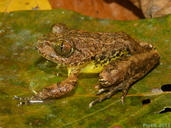|
Astylosternus fallax Amiet, 1978
| family: Arthroleptidae genus: Astylosternus |
| Species Description: Amiet , J.-L. (1977). "Les Astylosternus du Cameroun (Amphibia, Anura, Astylosternidae)." Annales de la Faculté des Sciences de Yaoundé, 23–24, 99–227. | |
 © 2013 Daniel Portik (1 of 1) |
|
|
|
Description Tadpoles have a total length between 45 - 74 mm. The body length to total length ratio is 36.3 ± 2.6%. The ventral-fin-height to dorsal-fin-height ratio is 68.9 ± 11.5%. The anterior lip papillae are positioned laterally, and the posterior papillae are in 2 to 3 rows of 20 triangular papillae. The papillae of the inner row are shorter than the marginal row. The keratodont formula is 1:2+2/2+2:1. The rostral gap is large and the jaw sheaths are massive and serrated. The upper jaw has a medial fang, and the lower jaw is U-shaped with a broad medial notch (Griesbaum et al. 2019). The adult dorsal coloration is brown, beige, or olive speckled with light spots and irregular, round, dark markings. The ventral coloration is bright yellow, turning to pink scattered with dark spots under the throat, and very little pigmentation on the legs. The hind limbs have two to six small transverse bands, and the forelimbs have two transverse bars which are less visible and interrupted (Amiet 1977). The tadpoles' coloration is pale brown and the dorsal surface is darker. The back and the tail have irregular, big, dark brown spots or blotches. The venter is pale with little or no dark speckling. Tail fins are beige and semi-transparent with dark brown spots. The jaw sheaths are black (Griesbaum et al. 2019). Distribution and Habitat Country distribution from AmphibiaWeb's database: Cameroon
Life History, Abundance, Activity, and Special Behaviors On Mt. Nlonako, A. fallax has been found at the same sites as A. diadematus and A. perreti (Plath et al. 2004; Herrmann et al. 2005). Trends and Threats Relation to Humans Comments Phylogenetic relationships Preliminary genetic studies have found two clades in the genus, a West African clade and a Central African clade (Portik et al. 2019). The phylogenetic placement of A. fallax likely falls into the Central African clade (Allen et al. unpublished data).
References
Amiet, J.-L. (1977). ''Les Astylosternus du Cameroun (Amphibia Anura, Astylosterninae).'' Annales de la Faculté des Sciences de Yaoundé, 23/24, 99-227. Channing, A., Rödel, M.-O. (2019). Field Guide to the Frogs and Other Amphibians of Africa. Penguin Random House South Africa, Cape Town, South Africa. Griesbaum, F., Hirschfeld, M., Barej, M. F., Schmitz, A., Rohrmoser, M., Dahmen, M., Mühlberer, F., Liedtke, H.C. Gonwouo, N.L., Doumbia, J., Rödel, M. O. (2019). "Tadpoles of three western African frog genera: Astylosternus Werner, 1898, Nyctibates Boulenger, 1904, and Scotobleps Boulenger, 1900 (Amphibia, Anura, Arthroleptidae)." Zoosystematics and Evolution, 95, 133–160. [link] Herrmann, H.-W., Böhme, W., Herrmann, P.A., Plath, M., Schmitz, A., Solbach, M. (2005). ''African biodiversity hotspots: the amphibians of Mt. Nlonako, Cameroon.'' Salamandra, 41(1/2), 61–81. IUCN SSC Amphibian Specialist Group. (2017). "Astylosternus fallax." The IUCN Red List of Threatened Species 2017: e.T54417A95841677. https://dx.doi.org/10.2305/IUCN.UK.2017-2.RLTS.T54417A95841677.en. Accessed on 09 February 2022. Lawson, D. P. (1992). "The herpetofauna of Korup National Park, Cameroon: biogeography and comparative biodiversity of a tropical African rainforest." Doctoral dissertation, The University of Texas at Arlington Plath M, Solbach M, Herrmann H-W (2004). ''Anuran habitat selection and temporal partitioning in a montane and submontane rainforest in southwestern Cameroon – first results.'' Salamandra (Frankf), 40, 239-260. [link] Portik DM, Bell RC, Blackburn DC, Bauer AM, Barratt CD, Branch WR, Burger M, Channing A, Colston TJ, Conradie W, Dehlin JM, Drewes RC, Ernst R, Greenbaum E, Gvozdík V, Harvey J, Hillers A, Hirschfeld M, Jongsma GFM, Kielgast J, Kouete MT, Lawson LP, Leaché AD, Loader SP, Lötters S, van der Meijden A, Menegon M, Müller S, Nagy ZT, Ofori-Boateng C, Ohler A, Papenfuss TJ, Rößler D, SinschU, Rödel MO, Veith M, Vindum J, Zassi-Boulou AG, McGuire JA (2019). ''Sexual dichromatism drives diversification within a major radiation of African amphibians.'' Systematic Biology , 68(6), 859-875. [link] Originally submitted by: Kaitlin E. Allen, Magali Zoungrana, David C. Blackburn (2022-04-27) Description by: Kaitlin E. Allen, Magali Zoungrana, David C. Blackburn (updated 2022-04-27)
Distribution by: Kaitlin E. Allen, Magali Zoungrana, David C. Blackburn (updated 2022-04-27)
Life history by: Kaitlin E. Allen, Magali Zoungrana, David C. Blackburn (updated 2022-04-27)
Trends and threats by: Kaitlin E. Allen, Magali Zoungrana, David C. Blackburn (updated 2022-04-27)
Relation to humans by: Kaitlin E. Allen, Magali Zoungrana, David C. Blackburn (updated 2022-04-27)
Comments by: Kaitlin E. Allen, Magali Zoungrana, David C. Blackburn (updated 2022-04-27)
Edited by: Ann T. Chang (2022-04-27) Species Account Citation: AmphibiaWeb 2022 Astylosternus fallax <https://amphibiaweb.org/species/1482> University of California, Berkeley, CA, USA. Accessed May 15, 2025.
Feedback or comments about this page.
Citation: AmphibiaWeb. 2025. <https://amphibiaweb.org> University of California, Berkeley, CA, USA. Accessed 15 May 2025. AmphibiaWeb's policy on data use. |



 Map of Life
Map of Life